The German Warmblood horse breed boasts a rich history and a versatile skill set that make it a popular choice among equestrians worldwide. This majestic breed has captured the hearts of many, thanks to its graceful appearance, captivating personality, and remarkable aptitude in various equestrian disciplines. By delving into the breed’s fascinating origins, understanding its characteristics, and exploring its breeding practices and health care, one can gain a true appreciation for the esteemed German Warmblood horse breed.
Table of Contents (Horspedia)
History and Origin
Ancestors and Foundation
The German Warmblood horse breed is a group of middleweight sport horses that comprise several distinct regional breeds within Germany. These breeds share several common ancestors, which played crucial roles in the development of the modern German Warmblood. The ancestral stock largely includes native German breeds, such as Oldenburg, Hanoverian, and Holsteiner horses. These breeds were utilized for various agricultural and transportation tasks in the past, but eventually evolved into specific sports breeds due to their strength, speed, and adaptability.
Development and Role of Thoroughbreds in the German Warmblood Breed
During the early 18th century, Thoroughbreds were introduced to Germany and were extensively used to refine and improve local breeds. Thoroughbreds contributed valuable genes for athleticism, speed, and endurance to the German Warmblood stock. Gradually, German breeding programs began to shift their focus towards combining the desirable traits from both local and imported breeds to meet the growing demand for versatile sport horses that excelled in dressage, show-jumping, and cross-country events. This led to the establishment of studbooks for specific regional warmblood breeds such as the Hanoverian, Holsteiner, and Oldenburg.
Origins in Germany
The German Warmblood horse breed can be traced back to its origins in various regions of Germany, each with its own distinct regional breeding programs. Some of the best-known and most influential German Warmbloods include the Holsteiner, which originated in Schleswig-Holstein; the Oldenburg, which hails from the Lower Saxony region; and the Hanoverian, which was founded in the 18th century at the Celle State Stud in Lower Saxony.
These regional breeds, along with others like the Westphalian, Rhinelander, and Baden-Württemberger, were developed independently and adapted to the specific needs of their local populations. Over time, a shared focus on producing high-quality sport horses led to the convergence of these regional breeding programs and the modern concept of a unified German Warmblood breed.
Modern Worldwide Influence
Today, the German Warmblood horse breed is not only popular within Germany itself but has also gained international recognition in the equestrian world. Many German Warmblood horses are exported worldwide, where they continue to excel in competition and contribute to the national breeding programs of other countries. German Warmblood stallions and mares are often used as foundation stock in other warmblood breeding programs, and their versatile nature and superb athleticism have made them a popular choice among equestrian enthusiasts across the globe.
Introduction to German Warmblood Horses
German Warmblood horses are highly regarded for their athleticism, versatility, and adaptability, which can be attributed to the country’s comprehensive breeding programs and strict breeding standards. The German Equestrian Federation collaborates with regional breeding associations to ensure that all German Warmblood horses come from quality bloodlines and are capable of excelling in various equestrian sports. As a result, German Warmblood horses have become one of the most renowned and respected horse breeds worldwide.
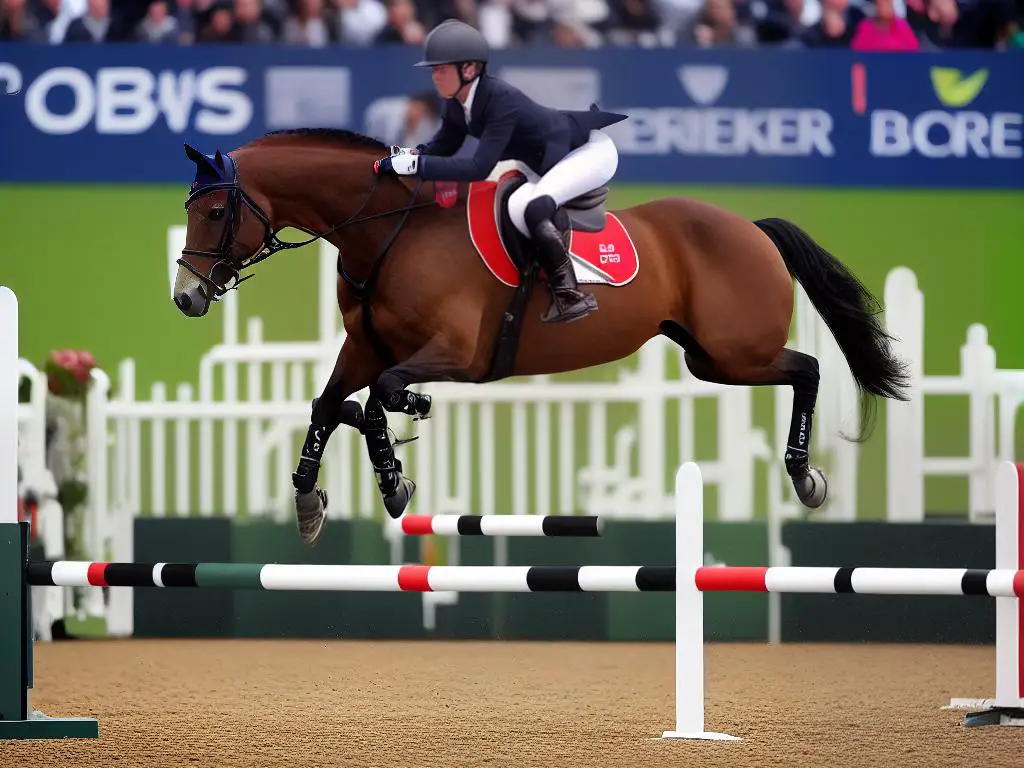
Breed Characteristics
Breed Varieties and Characteristics
The term German Warmblood refers to a group of horse breeds originating in Germany, each with their own unique characteristics and suitable disciplines. Some of the most popular German Warmblood breeds include the Hanoverian, Oldenburg, Westphalian, and Holsteiner. These horses are known for their good temperament, making them easy to train and work with in a variety of equestrian disciplines. In this article, we will explore the general traits of German Warmblood horses, their ideal disciplines, and their color patterns.
Physical Characteristics
Typically, German Warmblood horses stand between 15.2 and 17.2 hands high, with the average height being around 16 hands. They have a well-proportioned build with strong muscles, a deep chest, and a sloping shoulder. Their hindquarters are powerful, and their legs are long and elegant with strong joints and hooves. Overall, the German Warmblood has a balanced and substantial appearance, which contributes to its excellent athleticism and performance capabilities.
German Warmbloods are known to have beautiful heads, often with a straight or slightly convex profile. They have large, expressive eyes and well-set ears, showing off their intelligence and alertness. The neck of these horses is long and well-set, giving them a proud and elegant appearance.
Temperament
One of the most beloved traits of the German Warmblood is its temperament. These horses are known for being calm, friendly, and willing to please, making them very trainable and easy to work with. Despite their warm personalities, they are also highly athletic and driven, with a good work ethic that makes them a favorite among professional and amateur riders alike.
Color Patterns
German Warmblood horses can be found in a wide variety of colors and patterns. Common solid colors include bay, chestnut, gray, and black. There are also horses with more unique colors, such as palomino, buckskin, and pinto. It’s important to note that while German Warmbloods can come in many different colors, most breed registries prioritize the horse’s conformation, movement, and performance over coat color.
Suitability for Different Disciplines
German Warmblood horses excel in a wide variety of equestrian sports, including dressage, show jumping, eventing, and driving. They are often seen competing at the highest levels of these disciplines, and many German Warmbloods have become Olympic champions. The breed’s combination of athleticism, good temperament, and trainability make them highly sought-after among riders and trainers for competitive disciplines.
In addition to their competitive success, German Warmbloods are also well-suited for pleasure riding. Their calm and friendly nature makes them enjoyable to ride for amateur and recreational riders who value a pleasant and safe mount.
Introduction
German Warmblood horses have long been celebrated for their outstanding physical traits and desirable temperaments, which they owe in large part to the dedicated and systematic breeding programs responsible for their development. These versatile equines excel in various equestrian disciplines, making them a popular choice among riders of all skill levels. As a result, German Warmbloods have become one of the most respected and admired horse breeds in the world.
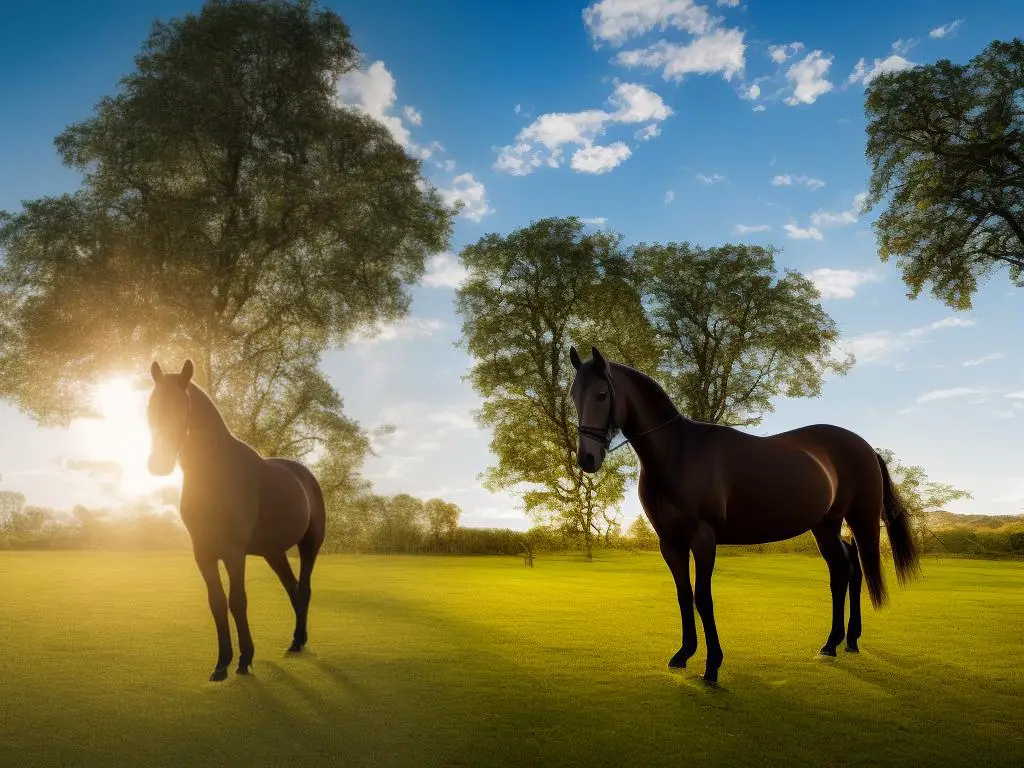
Breeding and Registration
Breeding Goals and Methods
The ultimate objective of breeding German Warmbloods is to create an athletic horse with extraordinary qualities that make it well-suited for various equestrian disciplines, such as dressage, show jumping, and eventing. Breeders concentrate on enhancing traits like temperament, rideability, conformation, and performance through selective breeding and careful evaluation of prospective breeding stock based on pedigree, performance, conformation, and genetic factors.
By following a methodical approach, breeders ensure the continued development of German Warmblood horses’ versatility and excellence. Performance testing is implemented for both stallions and mares, allowing only those that pass stringent quality criteria to contribute to the gene pool. In this way, German Warmblood breeding programs not only build upon the successes of proven bloodlines but also foster the development of new genetic progress that benefits the breed as a whole.
German Warmblood Studbooks
Several regional studbooks regulate the breeding and registration of German Warmblood horses. These studbooks fall under the umbrella of the German Equestrian Federation (FN). The most well-known regional studbooks include the Hannoveraner Verband, Holsteiner Verband, Westfälisches Pferdestammbuch, and Oldenburger Pferdezuchtverband. Each of these studbooks has its own set of rules and regulations, as well as specific breeding goals. However, they all collectively collaborate to maintain the overall high standard of the German Warmblood breed.
Inspection Process
Before a German Warmblood horse can be registered, it must go through a stringent inspection process to ensure it meets the required breed standards. The inspection process is held annually at various locations and organized by the respective regional studbook. Mares, foals, and stallions can be presented for inspection.
During the inspection, the horses are evaluated by a panel of experienced judges who carefully assess various aspects, including conformation, movement, and temperament. The evaluation process helps determine the suitability of the horse for breeding, as well as its potential for sport. Horses that do not meet the breed standards may be excluded from the studbook, thereby maintaining the quality of the breed.
Stallion Licensing and Performance Testing
All German Warmblood stallions must undergo a rigorous licensing process before being allowed to breed. Unlicensed stallions cannot have their offspring registered in the official studbooks. The licensing process typically takes place when the stallion is around two and a half years old, and involves an evaluation of its conformation, movement, and jumping ability.
Once a stallion has been granted a license, it is required to undergo a performance test. This test commonly lasts approximately 50 days and is designed to assess the stallion’s rideability, temperament, and potential as a suitable sire for sport horses. The performance test includes evaluations under saddle, as well as jumping and dressage assessments. Stallions that pass the performance test are then eligible to be entered into the studbook and used for breeding purposes.
Mare Performance Testing and Selection
While not as rigorous as the stallion licensing and performance testing process, mares are also encouraged to participate in mare performance tests. These tests help to identify high-quality mares for breeding. The mare performance tests assess rideability, movement, and jumping ability, and provide valuable information for breeders when selecting suitable mares for their breeding program.
German Warmblood Horses
German Warmblood horses, known for their athleticism and versatility, are a popular breed among horse enthusiasts, especially in dressage, show jumping, and eventing. To maintain optimal health and performance, these horses require proper care and attention, including routine veterinary care, dietary management, regular grooming, and exercise. The German Warmblood breed attributes its high-quality standards due to rigorous registration processes and breeding practices, which are influenced by continuous collaboration among the regional studbooks and the German Equestrian Federation.
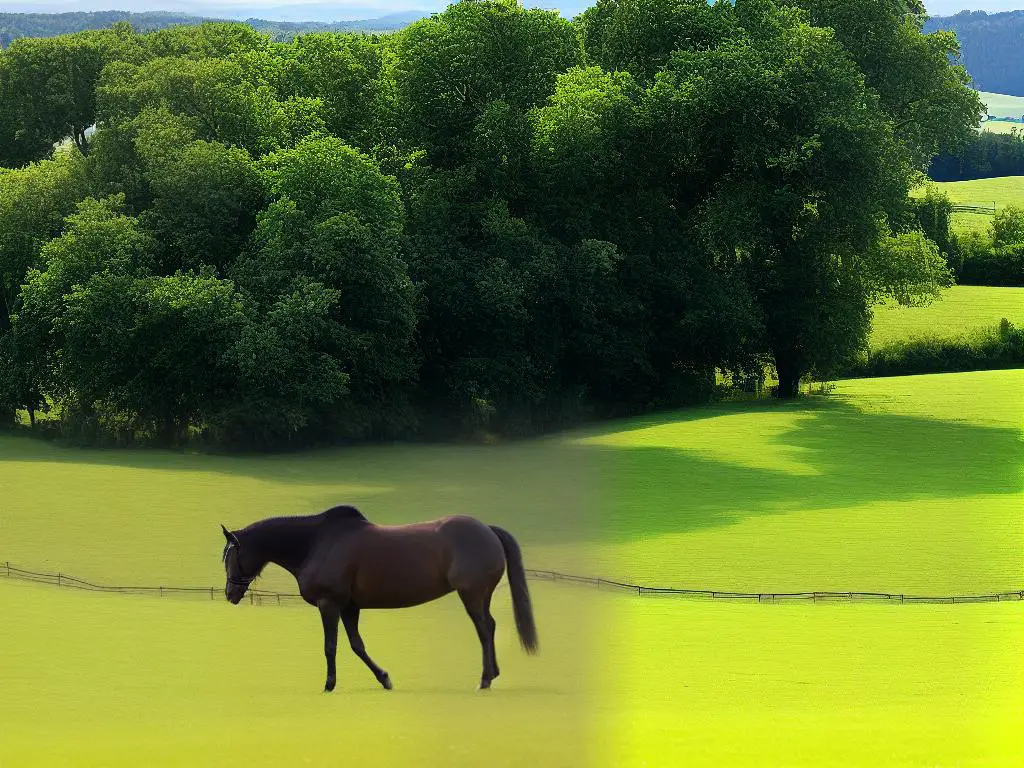
Health and Care
Breeding Practices and Excellence
The foundation for the breed’s uniformity and excellence is the result of a stringent inspection process, stallion licensing, and mare selection that ensure only the finest horses contribute to the German Warmblood gene pool. Due to these practices, exceptional sport horses are bred that continue to excel in the equestrian world, taking pride in their lineage and representing the best of the German Warmblood breed.
Common Health Issues
While German Warmbloods are generally hardy and robust, they can be prone to certain health issues common to warmblood breeds. Osteochondritis Dissecans (OCD), a developmental orthopedic disease affecting the cartilage and bones, can occasionally occur in these horses. Regular veterinary check-ups can help identify and address OCD early on, minimizing its impact on the horse’s long-term health.
Wobblers Syndrome, which affects the spinal cord and causes instability, is another condition occasionally found in German Warmbloods. Prompt diagnosis and treatment are essential in managing this condition, which may require surgery in some cases. Additionally, Equine Metabolic Syndrome and various allergies are other health concerns that German Warmblood owners should be aware of and actively seek to prevent through proper care and nutrition.
Nutrition and Diet
German Warmbloods require a balanced and nutritious diet to maintain peak health and performance. The primary component of their diet should be high-quality forage, such as hay or pasture, to provide essential fiber and nutrients. Additionally, feeds formulated specifically for active sport horses may be beneficial in providing the required vitamins, minerals, and calories while preventing weight gain that could be detrimental to their athletic ability.
Ensuring that fresh water is always available is also crucial for the horse’s health, and salt blocks should be provided in the stable or pasture to encourage adequate water intake and electrolyte balance.
Grooming and Stable Management
Regular grooming is essential for maintaining the health and appearance of a German Warmblood. Beyond improving their appearance, grooming helps to ensure that their skin and coat remain clean and free of parasites, promotes good circulation, and provides an opportunity to check for any developing health issues.
Hoof care is a vital aspect of grooming, and the horse’s hooves should be cleaned and checked daily for early detection of potential problems such as cracks, abscesses, or thrush. A farrier should trim and reset shoes every six to eight weeks to ensure proper hoof health and balance.
Keeping your horse’s stable clean and well-ventilated is important for ensuring their respiratory health. Regular mucking out of stalls and providing clean, dry bedding, such as shavings or straw, helps to minimize the risk of respiratory problems and parasites. Ideally, your horse should spend time daily in a pasture, allowing for natural grazing and social interaction with other horses.
Exercise and Training
German Warmbloods are bred for athleticism, and they thrive when provided with regular and varied exercise. Depending on your chosen discipline, a blend of flatwork, dressage, schooling, and jumping will help keep the horse mentally stimulated, physically fit, and prevent boredom. Allowing time for relaxed hacks and turnout in addition to structured training sessions reinforces their natural instincts and contributes to their overall wellbeing.
Introducing German Warmblood Horses
German Warmblood horses are renowned for their athleticism, versatility, and temperament, making them a highly sought-after breed in various equestrian disciplines. Most notably, they excel in dressage and show jumping, where they have won numerous championships and set world records. With proper healthcare, nutrition, grooming, and exercise, German Warmbloods can lead a long and active life, often exceeding 20 years of age. Building a strong relationship with your veterinarian, farrier, and trainer, and consistently monitoring your horse’s health will help ensure that your German Warmblood remains a happy and successful equine partner.
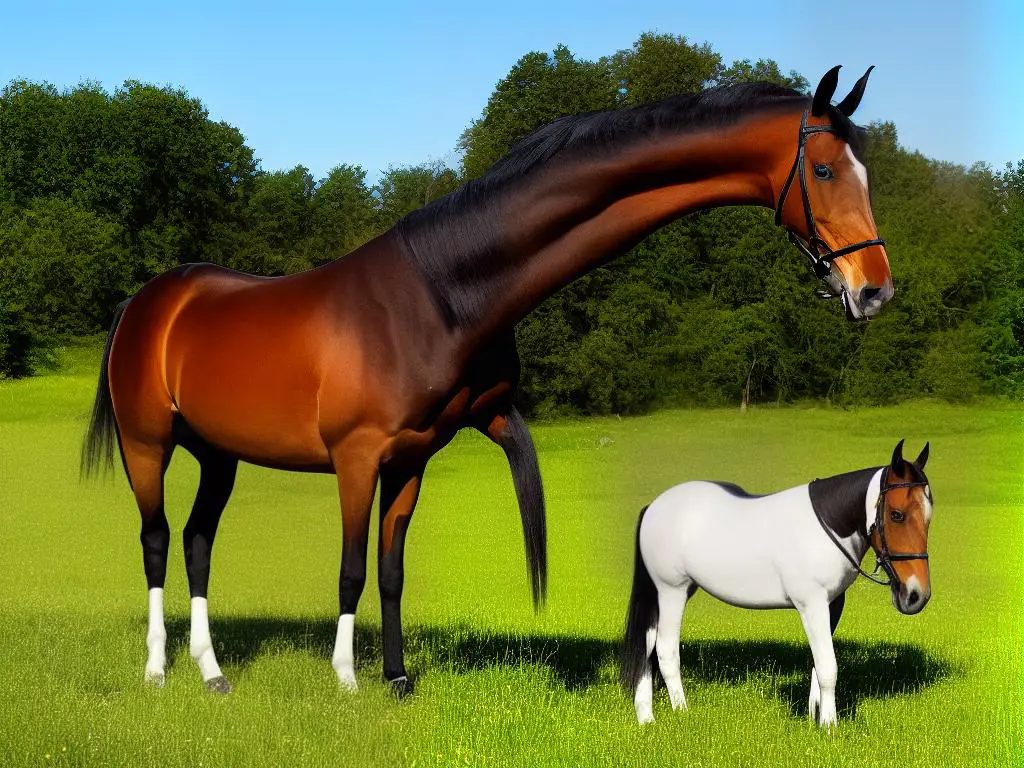
Notable Horses and Achievements
Notable German Warmblood Horses and Achievements
One example of a highly accomplished German Warmblood is the Westphalian gelding “Rembrandt,” ridden by Dutch rider Anky van Grunsven. Together, they won multiple Olympic, World, and European Championships in dressage, becoming one of the most successful dressage partnerships in history. Rembrandt’s elegant movement and exceptional trainability showcased the qualities that make German Warmbloods so desirable for dressage competition.
“Totilas,” a black Dutch Warmblood stallion with German origins, is another immensely successful German Warmblood. Ridden by Germany’s Matthias Alexander Rath and previously by the Netherlands’ Edward Gal, Totilas set world records in dressage and became the first horse to score above 90 percent in international competition. Totilas’ athleticism and expressive presence have made him a highly sought-after sire, with his offspring often commanding top prices at auction.
In the realm of show jumping, the Hanoverian gelding “Shutterfly,” ridden by German rider Meredith Michaels-Beerbaum, stands out as one of the most successful German Warmbloods in the sport. Shutterfly earned multiple World Cup titles, European Championships, and top placings at the Olympic Games. Shutterfly’s natural talent for jumping and careful technique exemplify the traits of top German Warmblood show jumpers.
Famous Trainers and Riders
German trainers and riders have played a significant role in the development and success of German Warmbloods on the international stage. Some notable examples include:
- Klaus Balkenhol, a former German Olympic dressage team coach, has worked with several German Warmbloods and helped to develop the careers of successful horses like “Goldstern” and “Donna Asana.” His classical training methods and commitment to the well-being of the horses have made him highly respected in the equestrian community.
- Paul Schockemöhle, a former show jumping champion, is now a renowned breeder and trainer of German Warmbloods. His breeding program produced numerous successful sport horses, including the famous stallion “Sandro Hit.” Schockemöhle’s expertise in selecting and developing young prospects has helped to maintain the high quality of the German Warmblood breed.
- Ludger Beerbaum is a legendary German show jumping rider who has worked with numerous successful German Warmbloods throughout his career, including “Goldfever,” “Ratina Z,” and “Chiara.” Beerbaum’s ability to develop a strong partnership with his horses, combined with his impressive riding skills, has made him an integral figure in the promotion of German Warmbloods in show jumping.
Impact on the Equestrian World and Influence on Other Breeds
German Warmbloods have had a significant impact on the equestrian world, being highly sought-after for their natural talent, trainability, and versatility. Their success in international competitions has led to increased demand for these horses, and as a result, many breeders around the world are incorporating German bloodlines into their breeding programs.
The influence of German Warmbloods is evident in other breeds as well. For instance, many Dutch Warmbloods and Belgian Warmbloods have incorporated German bloodlines, resulting in horses that combine the best qualities of both breeds. This cross-breeding has led to the development of exceptional sport horses that continue to achieve success in various equestrian disciplines.
Overall, the German Warmblood breed has firmly established itself as one of the essential horse breeds in the equestrian world. Their impressive achievements in international competition and the contributions of prominent riders and trainers have further solidified their reputation as top sport horses. The enduring influence of German Warmbloods on other breeds is a testament to their exceptional qualities and unparalleled success in equestrian sports.
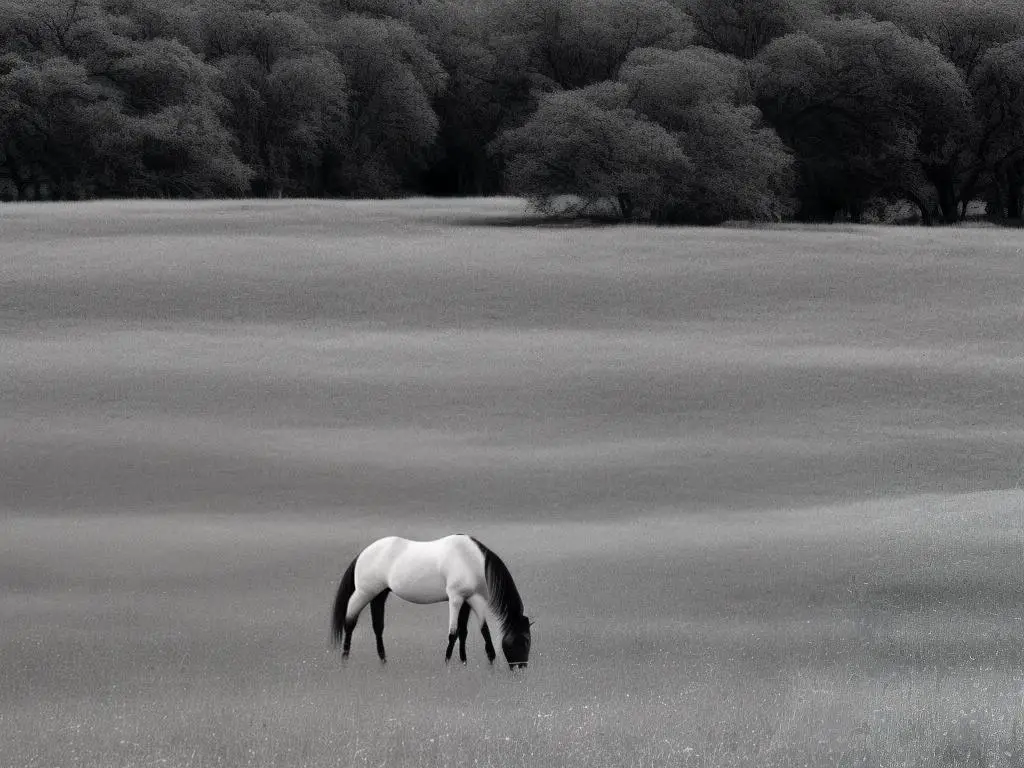
Throughout its storied history, the German Warmblood has ascended the ranks of the equestrian world, earning numerous accolades and praise for its noteworthy contributions to various disciplines. By staying informed and appreciating the breed’s unique characteristics, health needs, and achievements, one can truly honor the legacy and enduring impact of the German Warmblood horse breed. As admirers, owners, and riders alike celebrate this remarkable horse, its influence will continue to resonate within the global equine community for generations to come.
